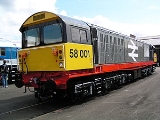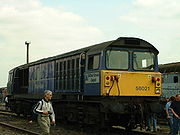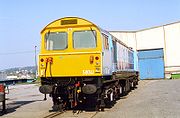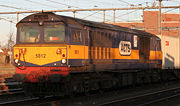
British Rail Class 58
Encyclopedia

British Rail
British Railways , which from 1965 traded as British Rail, was the operator of most of the rail transport in Great Britain between 1948 and 1997. It was formed from the nationalisation of the "Big Four" British railway companies and lasted until the gradual privatisation of British Rail, in stages...
Class 58 is a class of Co-Co diesel locomotive
Diesel locomotive
A diesel locomotive is a type of railroad locomotive in which the prime mover is a diesel engine, a reciprocating engine operating on the Diesel cycle as invented by Dr. Rudolf Diesel...
designed for heavy freight. Introduced in 1983, they followed American practice of modularisation
Modular design
Modular design, or "modularity in design" is an approach that subdivides a system into smaller parts that can be independently created and then used in different systems to drive multiple functionalities...
. From new they were painted in grey Railfreight Sector livery, instead of BR blue. EWS withdrew them in 2002 after 20 years in service, and 30 were subsequently hired abroad – four to the Netherlands
Netherlands
The Netherlands is a constituent country of the Kingdom of the Netherlands, located mainly in North-West Europe and with several islands in the Caribbean. Mainland Netherlands borders the North Sea to the north and west, Belgium to the south, and Germany to the east, and shares maritime borders...
, eight to Spain
Spain
Spain , officially the Kingdom of Spain languages]] under the European Charter for Regional or Minority Languages. In each of these, Spain's official name is as follows:;;;;;;), is a country and member state of the European Union located in southwestern Europe on the Iberian Peninsula...
and twenty to France
France
The French Republic , The French Republic , The French Republic , (commonly known as France , is a unitary semi-presidential republic in Western Europe with several overseas territories and islands located on other continents and in the Indian, Pacific, and Atlantic oceans. Metropolitan France...
.
History
In the late 1970s, British Rail wanted to develop a new, low-cost, easily maintainable freight locomotive that would handle the predicted rail freight growth during the 1980s. The Class 56British Rail Class 56
The British Rail Class 56 is a type of diesel locomotive designed for heavy freight work. It is a Type 5 locomotive, with a Ruston-Paxman power unit developing 3,250 bhp , and has a Co-Co wheel arrangement...
had a troublesome entry into service, and BR was also keen to enter the export market. Pre-production drawings of the Class 58s referred to them as "Standard Export Locomotives".
Once a design for the new Class 58 had been approved by the British Rail Board, the contract to build the locomotives was awarded to British Rail Engineering Limited (BREL) in Doncaster
Doncaster
Doncaster is a town in South Yorkshire, England, and the principal settlement of the Metropolitan Borough of Doncaster. The town is about from Sheffield and is popularly referred to as "Donny"...
where work started on a major multi-million pound upgrade of ‘E2’ shop where the locomotives would be manufactured. BREL dropped traditional locomotive construction methods in favour of an entirely new approach – an innovative modular design. This offered savings on construction and maintenance compared to previous locomotive builds. The load-bearing underframe was fitted with exchangeable modules - number 1 cab, radiator
Radiator (engine cooling)
Radiators are used for cooling internal combustion engines, mainly in automobiles but also in piston-engined aircraft, railway locomotives, motorcycles, stationary generating plant or any similar use of such an engine....
, power unit, turbocharger
Turbocharger
A turbocharger, or turbo , from the Greek "τύρβη" is a centrifugal compressor powered by a turbine that is driven by an engine's exhaust gases. Its benefit lies with the compressor increasing the mass of air entering the engine , thereby resulting in greater performance...
, electrical equipment and number 2 cab. If required, each module could be easily removed from the underframe and replaced.
The narrow body with cabs at either end led to them being given the nickname "Bone" by rail enthusiast
Railfan
A railfan or rail buff , railway enthusiast or railway buff , or trainspotter , is a person interested in a recreational capacity in rail transport...
s, but the design also made an American-style single cab version possible.
In service
The first locomotive, 58001, was handed over to British Rail at Doncaster Works on 9 December 1982 and delivery of the remainder of the locomotives followed over the next two years. 58050 was temporarily fitted with a Sepex wheelslip control system, but upon completion experimental testing the equipment was removed before the locomotive entered traffic with BR in 1987. SEPEX was central to the design of the Class 60. No export orders were received and so the jigs at Doncaster were dismantled and 58050 became not only the last Class 58 to be built, but the last diesel locomotive to be built at ‘The Plant’.Since they were introduced in the early 1980s, the 58s saw service on a variety of freight duties. Despite claims made at the time, their performance was actually inferior to Class 56s on many types of freight train due to their increased tendency to wheelslip, largely as a result of bogie design. Although originally allocated to coal traffic, their arrival coincided with the miners' strike
UK miners' strike (1984–1985)
The UK miners' strike was a major industrial action affecting the British coal industry. It was a defining moment in British industrial relations, and its defeat significantly weakened the British trades union movement...
, and British Rail apparently only tolerated the construction of so many because the components were already on order. As a result, the 58s could also be seen working other types of freight traffic. With the advent of privatisation in the 1990s, Class 58s greatly extended the geographical scope of their operations and were used on general freight traffic until withdrawal.
In their day, Class 58s were powerful and capable freight locomotives, although not without their flaws. However, by the turn of the century they compared unfavourably with the new generation of locomotives and were quickly supplanted by Class 66s. In comparison, Class 58s were expensive to maintain and operate, and delivered much lower availability.
Decline

Since then, the remainder of the Class 58s were stored at various points around Britain. This was hastened by the introduction of 250 Class 66
British Rail Class 66
The Class 66 is a six axle diesel electric freight locomotive developed in part from the British Rail Class 59, for use on the railways of the UK. Since its introduction the class has been successful and has been sold to British and other European railway companies...
s. The last few Class 58 locomotives were withdrawn in September 2001 after working the last charter train, the “Bone Idol” from King's Cross to Skegness
Skegness
Skegness is a seaside town and civil parish in the East Lindsey district of Lincolnshire, England. Located on the Lincolnshire coast of the North Sea, east of the city of Lincoln it has a total resident population of 18,910....
and return.
Seven Class 58s were put on the DB Schenker April 2010 disposals list. This is the first time stored Class 58s have been put up for sale. One of these, 58016, has entered preservation at Barrow Hill with the CL58G.
Service in Continental Europe


Netherlands
The Netherlands is a constituent country of the Kingdom of the Netherlands, located mainly in North-West Europe and with several islands in the Caribbean. Mainland Netherlands borders the North Sea to the north and west, Belgium to the south, and Germany to the east, and shares maritime borders...
on hire to Dutch container train operator ACTS. Since then, some members of the Class 58s fleet have also been sent to Spain
Spain
Spain , officially the Kingdom of Spain languages]] under the European Charter for Regional or Minority Languages. In each of these, Spain's official name is as follows:;;;;;;), is a country and member state of the European Union located in southwestern Europe on the Iberian Peninsula...
(on hire to Spanish infrastructure operator GIF) and more recently, a large number of Class 58s (alongside Class 56s) operated in France for Fertis, TSO and Seco Rail
Seco Rail
Colas Rail is a British rail freight company, formerly known as Seco Rail. Seco Rail was the name of the UK subsidiary of the French railway engineering company SECO which operates in Europe. SECO was founded in 1931. In 2000 SECO was purchased by the road building company Colas...
.
As of May 2007, all of the locomotives from the French contract have been returned to the UK and placed back into storage. The Spanish contract remain active at this time. The Dutch locomotives are sold to France.
Preservation
On 28 June 2010, DB Schenker confirmed that the Class 58 Locomotive Group's bid for 58016 had been accepted and thus the locomotive would become the first preserved example of its type. Shortly afterwards, on 7 July, the group announced they had also acquired another locomotive, 58045, as a spares donor. A subsequent posting on the group's website said that the stripping of 045 had proceeded apace and all parts recovered were to be initially stored until the restoration of 016 commences proper.Models
Between 1983 and 2006 Hornby RailwaysHornby Railways
Hornby Railways is the leading brand of model railway in the United Kingdom. Its roots date back to 1901, when founder Frank Hornby received a patent for his Meccano construction toy. The first clockwork train was produced in 1920. In 1938, Hornby launched its first 00 gauge train...
sold an 00 gauge
OO gauge
OO gauge or OO scale model railways are the most popular standard-gauge model railway tracks in the U.K. This track gauge is one of several 4mm-scale standards used, but it is the only one to be served by the major manufacturers...
model of a Class 58. This has been succeeded by a newer model by Danish manufacturer Heljan
Heljan
Heljan A/S is a Danish model railway company based in Søndersø. Originally specialising in decorations and accessories for model railways, it has now also developed a substantial range of rolling stock. It has diversified into modelling the British scene, and since 2002 have released several OO...
.
Dapol
Dapol
Dapol Ltd is a Welsh model railway manufacturer based in Chirk, Wales. The factory where design and manufacturing take place is just over the border in England.The Dapol trading name is known for its model railway products in N and OO gauges.-History:...
is producing a model in N scale
N scale
N scale is a popular model railway scale/track gauge. Depending upon the manufacturer , the scale ranges from 1:148 to 1:160. In all cases, the gauge is . The term N gauge refers to the track dimensions, but in the UK in particular N gauge refers to a 1:148 scale with track gauge modelling...
which was released in 2010.

